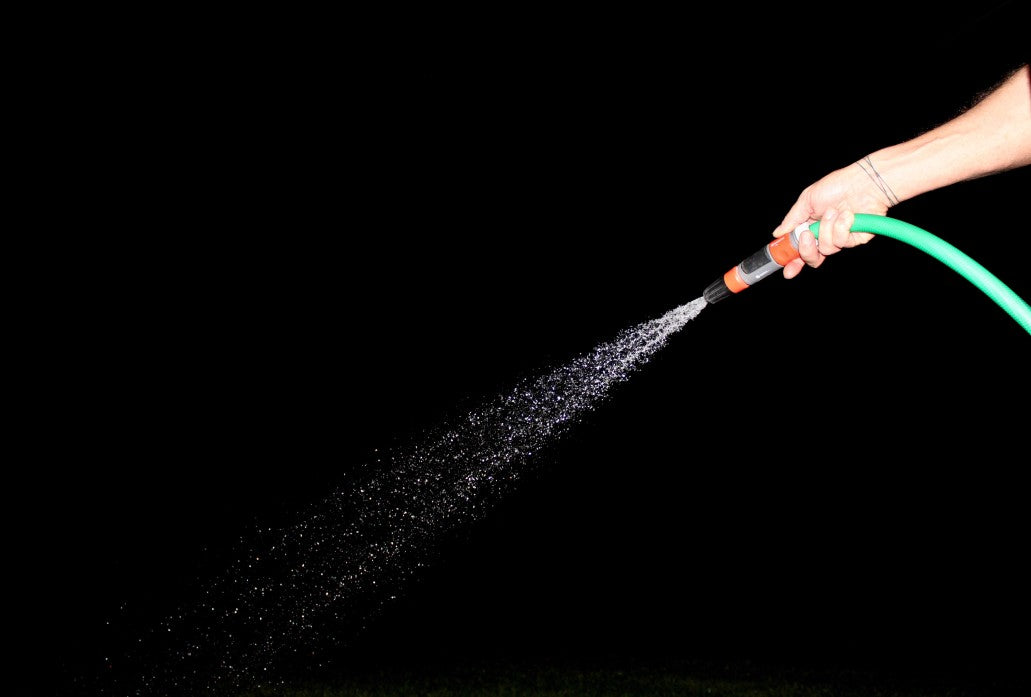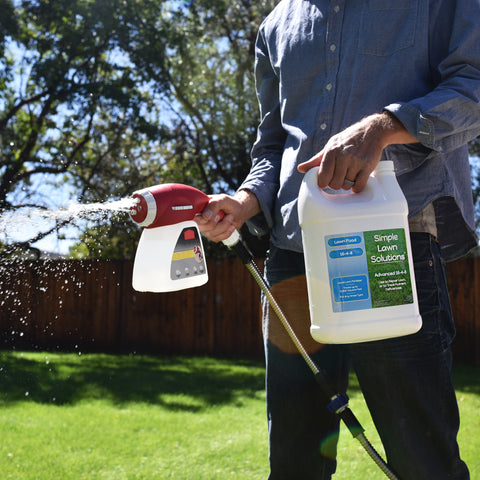When it comes to fertilizing your lawn, there are so many options to consider. Depending on your grass and soil needs, you will want to use a specific blend of nutrients in your application.
Liquid Fertilizer 101
Before we dive into comparing the specific fertilizer characteristics of liquid to granular fertilizer, let’s first understand what is involved when using a liquid fertilizer. Liquid lawn care is a newer lawn phenomenon that allows for a quick and more uniform application designed for quick absorption into the soil.
Liquid fertilizer has the same benefits as a traditional granular fertilizer, but with more added benefits:
- Easy-to-use
- No spreading equipment required
- Well-mixed nutrients for uniform application
- Faster nutrient uptake
You can use liquid fertilizer by attaching the bottle to your hose. The application of liquid fertilizer is comparable to merely watering your lawn. The mixture of nutrients within our liquid fertilizers are well-balanced and homogenous to allow for an equal distribution on your lawn. The benefit of liquid lawn care is that you don’t need to wait for rainfall or apply your hose or sprinkler for the ingredients to soak in. The fast-acting ingredients in our liquid fertilizer are absorbed by the soil so that you can see results quickly. By rapidly penetrating the ground, you can enhance your grass and soil's health much faster than granular fertilizer.
All About Granular Fertilizer
Granular fertilizer is the result of nutrients formed into dried pellets. For nutrients to release into the soil, granular fertilizer must have an application of water to break down into a more liquid state, aiding in the nutrient release.
Some pros of granular fertilizer are:
- Generally cheaper if purchased in bulk
- Easier to store and generally less temperature-sensitive
- Slow-release options (polymer-coated urea)
Nutrient Content of Our Favorite Liquids
The majority of fertilizers contain a blend of one or more of these macronutrients: nitrogen, phosphorus, and potassium. These nutrients are annotated with the abbreviation N-P-K, and different fertilizers will have a different blend of each, so you can customize your fertilizer nutrient application to what is necessary for your grass health and growth. Here are some of our favorite liquid lawn care food blends:
- 16-4-8 Lawn Food NPK - A perfectly balanced blend of Nitrogen, Phosphorus, and Potassium.
- 15-0-15 Phosphorous Free - Phosphate-free nutritional fertilizer is great for any area with a phosphate restriction.
- 3-18-18 High Phosphorus & Potassium NPK - Phosphorus and Potassium aid in stronger roots and plant hardiness.
With liquid lawn care, the fertilizer content is homogenous so that each fertilizer drop will have an identical amount of nutrients. With granular fertilizer, each granule comprises individual nutrient components that will not provide a homogenous application. Granular fertilizers slowly release nutrients as they become softened from watering or rain, while liquid fertilizers are fast-acting and will get to work as soon as you apply it onto your lawn.
Salt Content of Granular Fertilizer
A downside to granular fertilizer is that they can have a higher salt content than a liquid fertilizer, which can be detrimental to your lawn health. Salt is a dehydrating product and is harmful to your grass when over-applied. If you fertilize your grass to revive it from a dead or dried state, it is best to stay away from any fertilizers with higher salt content. When your soil has too much salt, it can prohibit nutrient penetration, which is the whole point of a fertilizer application.
Spatial Differences
When it comes to considering which type of fertilizer application is best for your lawn, you should also consider the spatial differences. The spatial difference refers to the difference in the area from plant roots to fertilizer nutrients. Some nutrients are less mobile, so it is best to apply fertilizer directly to the affected area. The farther the nutrient has to travel to a plant root, the less likely it is to be effective. Nutrients like phosphorus are considered less mobile so if your soil lacks this ingredient, consider opting for a more liquid solution like liquid fertilizer for maximum mobility. The watery nature of liquid lawn care will help nutrients travel down to the root more effectively and quickly.

What Equipment Do I Need?
One of the most significant benefits of liquid lawn care, including our liquid fertilizer, is that you don't need fancy equipment to apply these onto your lawn. Granular fertilizer requires spreading equipment.
The liquid fertilizer application is easy - attach your bottle of fertilizer to your hose, turn on the hose, and start spreading. With a thorough but straightforward lawn watering application, you will be on your way to healthy, green grass using the liquid fertilizer attachment.
The Best Time to Apply Liquid Fertilizer
Liquid fertilizer application is best for in-season applications when the plant is actively growing. To start the season off with a burst of nutrients and help with post-winter recovery, apply liquid lawn care food in April or May, or after your first mow of the season.
The application should take place during the cooler parts of the day, like early morning or later in the evening, to avoid overheating. It is also beneficial to apply fertilizer when working with a starter, such as grass seed, or before laying sod. Fertilizing the soil will give new grass the optimal conditions it needs to grow and establish roots.
This curated lineup of products is ideal for seeding new lawns. When it comes to applying liquid fertilizer, your grass will tell you when it’s time for some added nutrients, but you don’t have to wait until it’s too late. By keeping a close eye on these signs, you will know when it's ready for a dose of liquid lawn care food.
Prepping Your Lawn for Liquid Fertilizer
Before applying liquid fertilizer, there is another task that will help prep your soil for maximum benefits and nutrient absorption: lawn aeration. Lawn aeration is the process of "poking" small holes into your lawn, which allows for air, water, and nutrients applied through a fertilizer application to seep down into the grass-root quicker and more effectively.
This technique allows for lawn aeration and is a great technique to combat soil compaction and crusting as well. No matter your lawn issue, there are many reasons why your lawn could benefit from lawn aeration.
For best results when aerating and fertilizing, give your lawn a mow and a good watering 1-2 days before application.
Liquid Lawn Care
At Simple Lawn Solutions, we have various liquid products to make your typical lawn care applications more manageable and effective. We've talked about the benefits of going liquid when it comes to your fertilizer, but there are so many other areas of your lawn care that can be simplified by using a liquid lawn care product as well:
Simple Lawn Solutions
Our family is built upon three generations of professional and passionate lawn care expertise, so you know you are getting the best advice. From professional courses to extravagant landscapes and your neighborhood lawn, we have carefully researched, adjusted, and chosen products to meet the lawn care needs of any level of expertise.










